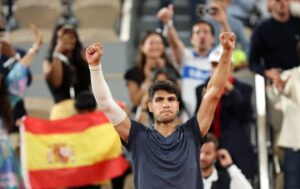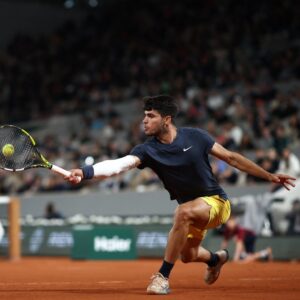
Modern-day sport is fast and furious. No matter what the discipline, the increase in speed and more furious action does give the fans an incredible adrenaline high. Hang on, we are not taking about Formula One, where the F1 beast’s speed is raw and tests the nerve. F1 was always like that, just that technology has souped it further.
Move to cricket, and the T20 version is indeed about better bats and batters where the poor bowler is at the mercy of the man across the 22-yard strip, almost waiting to club the white ball. Gone are the days when budding batsmen used finesse and technique in with bat and pad close together. Now it’s about smashing the ball, more cross-bat, more acceleration while swinging the bat as if it’s a club, like in baseball. Nobody minds it, as ‘Maximum’ is the mantra.
Tennis is not to be left behind, whatever the surface and venue, across continents – Australia, Europe and finally the climax in the Big Apple for the US Open. Watching tennis change has been very similar to how communication itself has. This generation may be unaware of old post cards, where secrecy did not matter. It took more than few days for a card to be posted and delivered. Then came the faster ways cards were delivered, like delivery of news, teleprinter, fax and then email. Of course, the world now lives in a University which produces no degree but offers everything as news and gossip – WA – the WhatsApp University.
Watching sport is about engagement, so French Open past midnight, if you live in India, is a bit surreal. The time difference between India and France is three and a half hours in summer. But then, to see ‘night’ matches, at Roland Garros, the hallowed precinct where the French Open is played, is indeed unique.
The weather is usually sunny in Paris but rain this time has added misery to the schedule. So, in such a scenario, when a marquee contest runs into night time, there is something wrong, fundamentally for the player as well as the fans. To be sure, Carlos Alcaraz versus Sebastien Korda was supposed to be one of the marquee matches. Alcaraz has won two Majors already, including one at the Big W on grass last year. For a young man who turned 21 last month, tennis has not been kind to his body.
For the Latest Sports News: Click Here

It’s easy to be a couch potato, smirk and say Alcaraz is not fit or his body is breaking down, far too often. He has already been through hundreds of scans, MRIs in medical jargon. His anatomy has been under scrutiny, for joints and the ‘hinges’ which hold his body have already faced trauma.
Insensitive fans have mocked his injury breaks, as he pulled out of premier clay tennis events. Yet, on Friday night, Alcaraz versus Korda produced sparks and spills. One may think, by nature, clay is softer and slower. No, maybe that was the case when you had old masters at play with wooden racquets in their hands. For old-timers, Bjorn Borg winning Wimbledon on grass from the baseline in the 1980s was a bit hard to digest.
Likewise, in the last two decades, tennis fans have been used to seeing one man dominate clay and Paris, Rafael Nadal. The winner of 22 Grand Slam titles, of which 14 came at Roland Garros, lost in the first round. He will play the Paris Olympics, come what may. And in this journey, he can enter the singles at his own peril. But where Rafa is eyeing a medal is in doubles, where he will want Alcaraz to prop him up.
Watching Alcaraz produce some scintillating tennis made for compelling viewing. His game is extremely physical, the lateral movement a must – breaking the speedy run to reach the ball and then again turn his body into the opposite direction, defying the laws of physics. That’s modern tennis for you, nothing in slow motion. One does not need to go to Newton’s laws, but for every action, even in tennis, there is an equal and opposite reaction.
In the case of Alcaraz, who produced amazing footwork through the three-set contest, what stood out was his physicality as he uncorked champagne stuff. The forehand was like a laser-guided missile. Obviously on clay, the ball does not speed like it does on hard courts or grass. What goes into that shot production, preparation, getting into position, balance, racquet-head acceleration and then the thwack of string hitting the tennis ball. For some, this noise is like music from old guitar strings, not electric.

What looked ugly was the arm-sleeve, but that’s what Alcaraz needs. He has a few issues with his arm and elbow, the serving one. The sleeve provides him protection, absorbs shock and at the same time does not affect his range of motion. Alcaraz has tweaked his service action a bit, maybe on the advice of biomechanics experts. As long as he can string together the points and win, who cares. Fans love him.
The match stats did tell a story, how Alcaraz dominated Korda with speed, better movement, greater reflexes and, of course, a speedier approach. His body has to hold up, despite plenty of pumping in the gym, tennis players are pounding their body parts to ensure that fans get more thrill. Yet, when a Rafa or Alcaraz break down or are in trouble, pain and out, there will be little sympathy.
An entry into the Round of 16 is good for Alcaraz. “It was a really good match, I think I played really well – much better than my previous matches,” said 21-year-old Alcaraz, later. “I wanted feel myself on court, I think I did that pretty well. ”
We also felt Alcaraz did well, though someone as big as Mats Wilander has already said younger players these days are more prone to injuries. Good old Mats has a valid point but he also knows the game has become extremely physical. Players like Alcaraz are the Alpha Males, yet they know, when it goes down the wire, a wily old fox called Novak Djokovic may still be lurking. A straight-set win was sublime. Yet, if the class master has to put a remark at the end of the report card, it will read: “Can do better.” That’s how hard tennis is today.